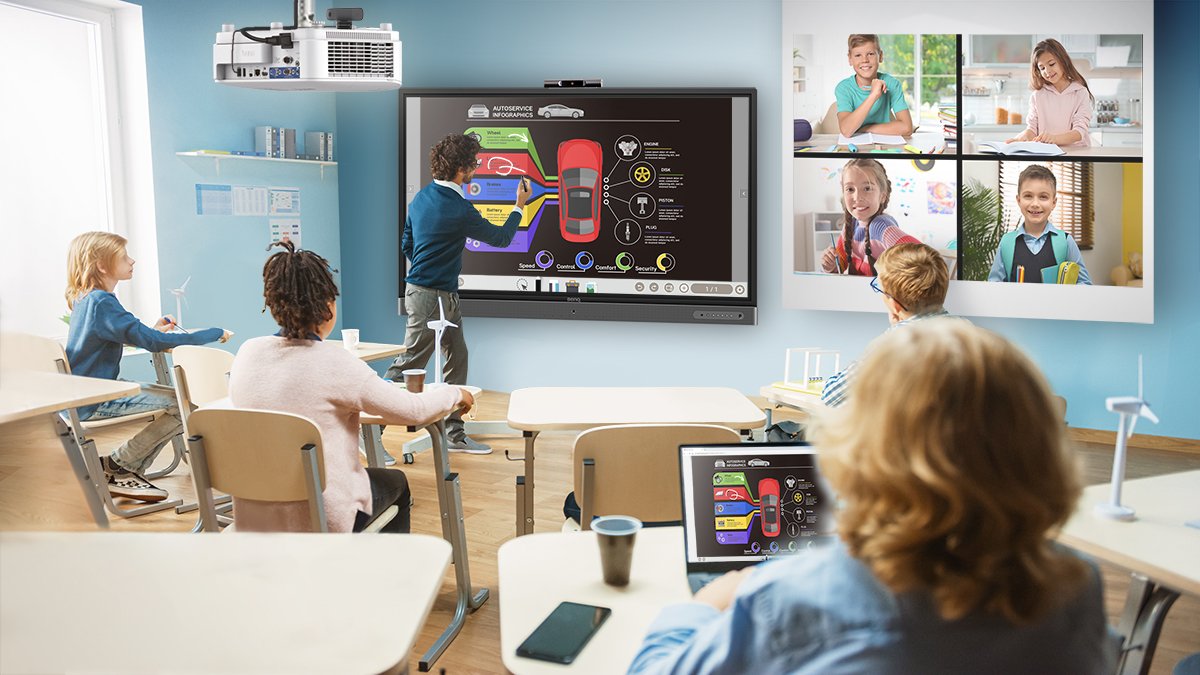What Are The Best Screen Mirroring Systems for Interactive Flat Panels?
- BenQ
- 2020-05-27

Not so long ago, the classroom experience was very different from what it is right now. A teacher would stand in the middle of the room and deliver the information to students. Students would make notes and later take tests to check their understanding of the lesson materials. Classrooms have changed and shifted from this traditional “teacher-lecture” approach to a student-centered approach where students are encouraged to work collaboratively and engage with each other and the teacher. Flat panels provide opportunities for collaboration and active learning. They allow students to interact with the display by using their mobile device.
If you are making a transition from projectors to interactive flat panels in your classrooms, wireless screen mirroring technology can increase collaboration and teacher effectiveness. Here are three key considerations on how to select the best wireless screen mirroring system for your new flat panels:
- Can students and teachers use them without training?
- Can the system be used with different types of devices (document camera, Blu-Ray player)?
- Does it reduce the bandwidth burden on the school network?
What are the different types of classroom screen mirroring technologies?
This article will compare popular wireless screen mirroring systems that will work with flat panels for classroom collaboration. We will examine three types of wireless screen mirroring systems commonly considered for education including systems that use:
- Standardized casting protocols like the ActionTec ScreenBeam
- School or campus WiFi networks like Airtame
- Plug-in HDMI transmitters like the BenQ InstaShow
How easy are wireless screen mirroring systems to use by teachers and students?
Classroom teachers want to use wireless technology quickly and easily – and students mustn't be wasting time trying to connect to a display. Corporations have a similar need in their meeting rooms, so how easy are these systems to use out of the box?
Standard screen casting receivers like ScreenBeam
With Miracast, Google Cast, and Airplay standardized casting protocols, you need to purchase a dedicated receiver such as the ScreenBeam to enable your device to share the screen. While these protocols are built into most devices, students and teachers will need to be trained on how to connect to the right network and select the correct display when using Miracast or Airplay from their device. For the IT manager, ScreenBeam has a 21-page deployment guide that recommends upgrading Quality of Service (QoS) adjustments to prioritize ScreenBeam network traffic and other network requirements and recommendations to ensure system performance.
Wi-Fi Screen Mirroring like Airtame
The Airtame system uses a similar approach but requires a special app to be installed on the student and teacher devices to be able to mirror their screen using a Wi-Fi network. The Airtame receiver is connected to the display and logged into the school network. Students use the app to send their content over the network to the flat panel. Like the ScreenBeam, AirTame2 has deployment directions that outline specific port requirement configurations and Quality of Service (QoS) adjustments to handle the increased traffic load during use.
HDMI Transmitter Buttons like InstaShow
The BenQ InstaShow models use HDMI transmitter buttons that can be plugged into any notebook or device. The teacher or student connects the button and taps the LED ring when ready to present without any apps.
The InstaShow S also supports standard screencasting protocols Miracast and Airplay, like the ScreenBeam – so teachers and students have a choice on which approach they want to take. No extra training or special network configurations are needed.
Recommended Product
Wireless Presentation System BenQ InstaShow WDC20

Which approach is the best? All of them.
While Miracast and Airplay are well suited for sharing information from your mobile phone or tablet, it may not work well in a collaborative environment such as a law firm or marketing agency where many types of devices may need to share the screen. Today, HDMI screen mirroring systems such as the BenQ InstaShow S can support both notebooks and AV devices with transmitter buttons, as well as any mobile devices using either Miracast or Airplay. With the InstaShow S, you can even have four different sources on the screen at the same time – enabling a MacBook, Chromebook, an iPhone, and an Android tablet to share their content – all with 128-bit encryption for a secure collaboration session.
What about wireless security?
Effective team collaboration requires an open environment where ideas can be shared confidentially. For wireless screen mirroring systems that only use Miracast or Airplay, this can be a problem as some standardized protocols have been subject to vulnerabilities that could lead to a bad actor capturing files or viewing confidential slides. By contrast, the InstaShow S has additional security protocols such as advanced encryption embedded into the transmitter's buttons and has been certified against common threats and vulnerabilities that hackers can use to view your content or access your network.
Sometimes it can be difficult to find answers to your questions when trying to find the right product. Since many resellers don’t have experts in this area that can help –where can you turn?
If you are looking for advice on choosing the right technology for your business or classroom, you can talk directly to an experienced BenQ product expert who has access to many different models and can guide you to the best one for your application. We also can help you find a reseller nearby, or if you want, you can purchase one right on the phone. Don't hesitate to contact BenQ Sales Team at your convenience.
Recommended Articles
-
Trends & Knowledge
Five Ways an Interactive Display Improves Student Engagement
Unique ways an interactive display can be used to increase classroom engagement, improving exam scores and retention rates.
2019.03.31 -
Trends & Knowledge
How BenQ’s Interactive Displays can minimize the spread of germs in classrooms
2020.04.21 -
Trends & Knowledge
Get wireless touch on interactive displays on your own laptop
2020.09.03